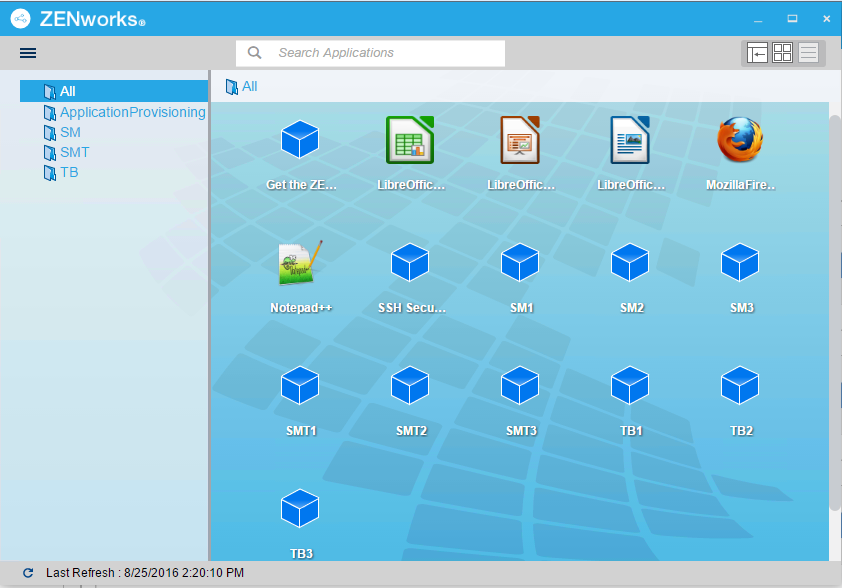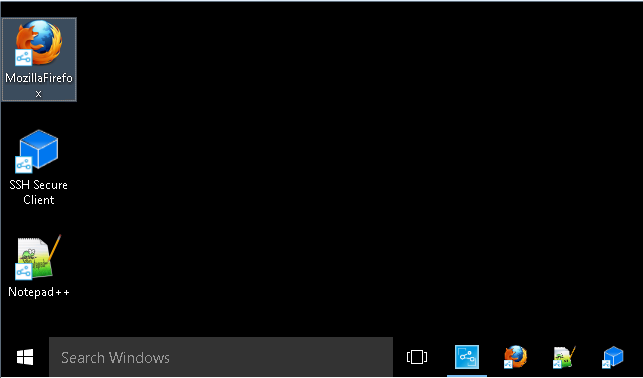13.3 Accessing Bundles
The ZENworks Agent provides three ways for you to access the bundles that are assigned to you:
13.3.1 ZENworks Window
The ZENworks Window is a standalone window that you can launch from the Start menu or the command prompt.
Using the Start Menu
-
Click Start > Programs > Novell ZENworks > ZENworks Application Window
The ZENworks Window left pane displays the following:
-
[All] folder: Contains all bundles that have been distributed to you, regardless of the folder in which they are located.
-
ZENworks folder: Contains all bundles that have not been assigned to a different folder. The ZENworks folder is the default folder for bundles; however, your administrator can create additional folders to organize bundles, and can even rename the ZENworks folder.
When you select a folder in the left pane, the right pane displays the bundles that are contained within the folder. You can:
-
Install a bundle or launch an application for an already installed bundle.
-
View the properties of a bundle. The properties include a description of the bundle, information about people to contact for help with the bundle, the times when the bundle is available for use, and the system requirements established for the bundle.
-
Repair an installed application.
-
Uninstall an application. This is an administrator-controlled feature that might not be enabled.
Using the Command Prompt
-
Open the command prompt and execute the following command:
zapp-launcher
The following command line switches can be used when starting the Application Window using zapp-launcher.
Table 13-1 Application Window Command Line Switches
|
Switch |
Description |
|---|---|
|
: EXAMPLE: zapp-launcher: |
Hides the initial splash screen. |
|
/? EXAMPLE: zapp-launcher /? |
Displays the help. |
|
/max EXAMPLE: zapp-launcher /max |
Displays the Application Window maximized when first loaded, overriding the window state (size and position) that was saved when exiting the previous Application Window session. |
|
/min EXAMPLE: zapp-launcher /min |
Displays the Application Window minimized when first loaded, overriding the window state (size and position) that was saved when exiting the previous Application Window session. |
|
/runonce EXAMPLE: zapp-launcher /runonce |
This command is used for internal purposes and it is located at HKLM\SOFTWARE\Microsoft\Windows\CurrentVersion\Run. Ensure that you do not delete it. |
|
/s EXAMPLE: zapp-launcher /s |
Makes the Application Window act like the Windows shell. For example, on the File menu, the Exit Application Launcher option changes to Shutdown and gives the user the standard Windows shutdown options. The Contents option on the Help menu is disabled. So, you cannot view the help. This is not a true replacement for the Windows shell. If users minimize the Application Window, they have access to the normal desktop. |
|
/d EXAMPLE: zapp-launcher /d |
Displays the Application Window with the Contents option on the Help menu disabled. So, you cannot view the help. |
|
/norm Example: zapp-launcher /norm |
Displays the ZENworks Application window in its original state when first loaded, and maintains the window state (size and position) that was saved when exiting the previous ZENworks Application window session. |
Using the ZENworks Window as the Windows Shell
If the ZENworks Window is used as a Windows shell, only the ZENworks Window is visible on the device. You do not have access to the device desktop so the Start menu, Quick Launch toolbar, and the ZENworks Icon are also not visible. Also, help is disabled on the device.
Using the ZENworks Window as a Windows shell is useful in scenarios where you want to restrict the user on the managed device to access only the applications displayed in the ZENworks Window. For example, if you want the user to access only applications such as Notepad and Calculator, ensure that the ZENworks Windows displays only these applications. To shut down the device, click File > Shutdown.
To use the ZENworks Window as a shell:
-
On the Windows device, run regedit.exe and locate the following setting:
HKEY_LOCAL_MACHINE\SOFTWARE\Microsoft\Windows NT\CurrentVersion\Winlogon
-
Change the SHELL value from explorer.exe to:
%zenworks_home%\bin\zapp-launcher.exeIf you want the ZENworks Window to be maximized when it comes up, add the /max switch to zapp-launcher.exe (for example, zapp-launcher.exe /max).
-
Close regedit.exe.
-
Restart Windows.
13.3.2 ZENworks Explorer
ZENworks Explorer is an extension to Windows Explorer that enables bundles to be displayed in Windows Explorer, on the desktop, on the Start menu, on the Quick Launch toolbar, and in the notification area.
Figure 13-1 Bundles Displayed in Windows Explorer

Figure 13-2 Bundles Displayed on the Desktop

You can perform the same tasks on the bundles in the ZENworks Explorer as you can in the ZENworks Window.
NOTE:Windows does not allow certain characters in folder paths ( \ / : * ? “< > | ). If you use any of these characters as part of the name of the ZENworks Explorer folder path, each character displays as an underscore ( _ ) in the Start menu. The characters display correctly in the ZENworks Window.
13.3.3 ZENworks Icon
The ZENworks Icon  is located in the Windows notification area. You can double-click the icon to display the ZENworks Agent properties. Located in the left navigation pane, the Bundles link lets you view the bundles that are assigned to you and to your device.
is located in the Windows notification area. You can double-click the icon to display the ZENworks Agent properties. Located in the left navigation pane, the Bundles link lets you view the bundles that are assigned to you and to your device.
The bundle list includes the following information:
-
Name: Displays the name of the bundle. Click the name to display the properties for the bundle, including such information as the version, folder and icon locations, and help contacts.
-
Status: Displays the installation status for the bundle.
-
Effective: Displays whether or not the bundle can be used on the device. If the Effective box is selected, the bundle meets all system requirements and constraints to be used. You can click the bundle icon
 to launch the bundle.
to launch the bundle.
If the box is not selected, it cannot be used; to find out why, click the bundle name to display the system requirements and properties.